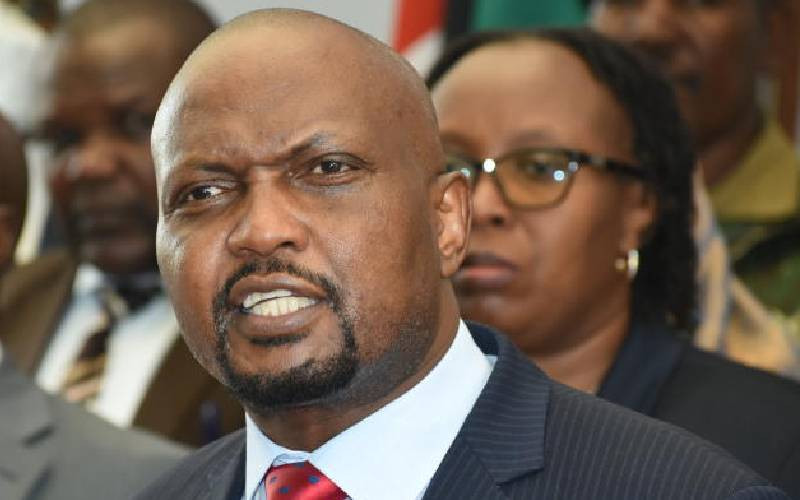By Luke Anami
The Government is eyeing a costly brain drain from the Civil Service after increasing the retirement age of public servants to 60 years.
Policy experts now warn that unless the entire promotion system in the service is also restructured, middle level staff aged between 30 to 45 years will leave to work in the private sector or abroad.
"People at the lower and middle levels of employment are likely to exit the civil service due to lack of upward mobility created by retaining over 55 years of age staff," said Ms Linet Oyugi, of the Institute of Policy Analysis & Research (IPAR) a local think tank.
"The chain of command system widely applied in the Civil Service will only lead to stagnation of careers for staff at their prime ages, further making it difficult to retain them," noted Oyugi, the economist in charge of the Macroeconomics programme at IPAR.
While increasing the mandatory age from 55 years to 60 years with effect from April 1, Public Service Minister Dalmas Otieno said there is still considerable capacity for staff to perform after the age of 55 years.
"At this age, most officers have gained valuable skills and technical experience, as well as advanced training in various fields," Otieno said.
Entry and exit
"The new scheme being portable and vesting in 10 years, will open public service for entry on merit, and exit on opportunity at all ages. Staff will not be tied anymore in the service because of past service pension benefits. New employees shall enter public service at all ages," said the minister.
Otieno admitted that Kenya’s Civil Service pensions are becoming a major fiscal burden, threatening to crowd out other programmes, especially health, education, and infrastructure, with limited tax.
However, IPAR observes that the solution is not to tie the increase of the retirement age to reducing Government expenditure passÈ, but to focus on service delivery in the Civil Service.
"Most people join the Civil Service as a last resort, and not because they want to. Majority are young fresh University graduates, who want jobs. As soon as they are trained and have their Masters degrees, there are high possibilities of them moving to the private sector," Oyugi said.
Given the massive development plans the Government puts in human resources, the gains may be lost if it fails to retain Civil Servants, by allowing for a flexible upward mobility in careers in the civil service.
Even though employers have welcomed the move, there is concern that it should be tied to other major factors, such as productivity.
"The Government will have to strengthen tools of performance measurement, if they are to realise any meaningful results from the move," pointed out Federation of Kenya Employers (FKE) Management Consultant, Jacob Onkunya.
Stay informed. Subscribe to our newsletter
"At 60 years, one has matured in talent and people management skills, a worthy effort in recognising that ability. However, the Government must move fast and entrench the culture of productivity in the civil service to tie efforts with results," added Onkunya, an economist.
Retirement age
Although it is currently the trend worldwide to have the retirement age at 60 years and above, mostly in the developed countries, due to lack of a young population, the case in developing countries is different. The International Labour Organisation (ILO) recommends retirement at the age of 62 years.
"In a developing economy like ours, there is supposed to be an input from the young generation," Onkunya observes.
Given that up to 12,000 Kenyans retire annually, one may argue that in essence it creates similar number of vacancies in the Civil Service.
If the new plan is implemented, 60,000 youth will miss jobs over the next five years.
Kenya has one of the highest numbers of unemployed youth in the world, with more than 52 per cent of the population falling within the 0-19 years age bracket, and persons aged 65 years and above at four per cent.
This group creates a high demand for the provision of socio-economic services, such as education, health, food, and shelter, among other requirements.
Notwithstanding the adverse effects, youth aged 15 to 24 years are a critical human resource for future economic and social development.
The age structure of a population affects its key socio-economic plans and structures. Countries with young populations (high percentage under the age 15 years) need to invest more in education and infrastructure, while countries with older populations (high percentage aged 65 years and over) need to invest more in the health sector.
 The Standard Group Plc is a
multi-media organization with investments in media platforms spanning newspaper
print operations, television, radio broadcasting, digital and online services. The
Standard Group is recognized as a leading multi-media house in Kenya with a key
influence in matters of national and international interest.
The Standard Group Plc is a
multi-media organization with investments in media platforms spanning newspaper
print operations, television, radio broadcasting, digital and online services. The
Standard Group is recognized as a leading multi-media house in Kenya with a key
influence in matters of national and international interest.
 The Standard Group Plc is a
multi-media organization with investments in media platforms spanning newspaper
print operations, television, radio broadcasting, digital and online services. The
Standard Group is recognized as a leading multi-media house in Kenya with a key
influence in matters of national and international interest.
The Standard Group Plc is a
multi-media organization with investments in media platforms spanning newspaper
print operations, television, radio broadcasting, digital and online services. The
Standard Group is recognized as a leading multi-media house in Kenya with a key
influence in matters of national and international interest.








